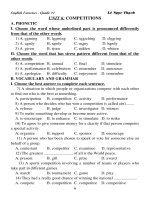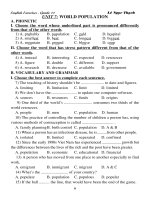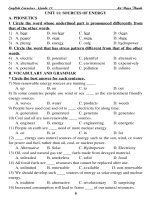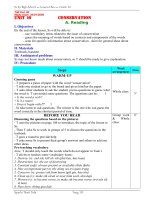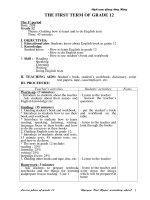Unit 9-12 Cb
Bạn đang xem bản rút gọn của tài liệu. Xem và tải ngay bản đầy đủ của tài liệu tại đây (159.19 KB, 11 trang )
Date of preparing:……/..../200…..
Date of teaching:……/ …./200…..
Class:………………
Unit 9
Deserts
---------------oOo-------------
Period N
o
55 - Lesson 1: Reading
I. Objectives:
1. Educational aim:
- Guessing the meaning in the context. Deciding true or false statements
- Passage comprehensions and Understanding the humour of the story.
2. Knowledge:
- General knowledge: Lives of plants animals in deserts.
- Language: Common knowledge of the life of plants and animals in the deserts
- New words: Words related to the lives of plants and animals in deserts.
3. Skills:
- Guessing meaning in context, deciding on true or false and passage comprehension.
II. Method:
- Integrated, mainly communicative.
III. Teaching aids:
- Picture, board, chalks, textbook, handouts,…
IV. Procedure:
Time
3
3
5
2
10
6
Teachers activities
- ask Ss to fill in the
blank with the most
suitable word.
- ask Ss to look at the
picture on page 96 and
ask and answer the
questions.
- go around the class
and offer help if
necessary.
- call on some Ss to ask
and answer in front of
the class.
- comment.
- read word by word.
- ask Ss to repeat in
chorus and individual
and write them on the
blackboard.
- say some words in
English and ask Ss to
speak them out in
Vietnamese.
- ask Ss to read the
passage in silence and
do task 1.
- ask Ss to compare the
answer with a partner.
- call on some Ss to
answer in front of the
class.
- comment and give
correct answer.
- present the task: Read
the passage and choose
the statements are True
or False.
Content
A. Warm- up (3): Fill in the blank with the
most suitable word:
A..is a hot, dry sandy place.
Answer:
Desert
B. Pre- reading:
I. Ask and answer the questions:
Suggested answers:
1. dry, few trees, little or no water, little
rainfall, few people and animals live in a
desert
2. camels, scorpions, cactus..
3. Egypt, Australia, China..
II. Vocabulary:
- aerial (adj) ['eril] : trên không
- dune (n) [dju:n] : đụn cát
- stretch (n) [stret]: dải đất, dải nớc
- aborigine (n) [,ổb'ridini:z] : thổ dân úc
- hummock (n) ['hmk] : gò, đống
- slope (n) [sloup] : dốc, đờng dốc
- corridor (n) ['krid:] : đờng hành lang
- crest (n) [krest] : đỉnh
- spinifex (n) ['spainifks] : cỏ lá nhọn sống
ở vùng hoang mạc nớc úc
III. Check vocabulary
C. While- reading
I. Task 1:
Answers:
1. kéo dài, căng ra
2. có cát,
3. trắc lợng trên không
4. Hội địa lý hoàng gia Austra
5. thổ dân Australia
6. cồn cát, đụn cát
7. độ dốc, dốc thoai thoải
8. dốc đứng, dốc ngợc
9. gò, đống
10. đỉnh (gò/đống)
11. cỏ lá nhỏn mọc trên hoang
mạc
II. Task 2: True- false
Answers:
1. F
2. F
3. T
Students activities
- fill in the blank with
the most suitable word.
- look at the picture on
page 96, listen to the
teacher then ask and
answer the questions in
the book.
- work in pairs.
- some Ss ask and
answer in front of the
- listen carefully
- repeat after the
teacher in chorus and
individual and write
down.
- do the task
individually.
- read the passage in
silence and do task 1.
- compare the answer
with a partner.
- some Ss answer in
front of the class.
- listen to the teacher
then read the passage
and choose the
statements are True or
False.
Date of preparing:……/..../200…..
Date of teaching:……/ …./200…..
Class:……………
Unit 9
Deserts
---------------oOo-------------
Period N
o
56 - Lesson 2: Speaking
I. Objectives:
1. Educational aim:
- Explaining why some kind of trees and animals can exit in the deserts.
2. Knowledge:
- General knowledge: The lives of trees and animals in the deserts.
- Language: + The way to make the life better in the deserts.
+ The tenses.
- New words: words related to the trees and animals in the deserts.
3. Skills:
- Talking about nature features of the deserts.
- Explaining why some thing should be brought along while going across a desert.
II. Method:
- Integrated, mainly communicative.
III. Teaching aids:
- Board, chalks, textbook, handouts.
IV. Procedure:
Time Teacher’s activities Content Students’
activities
5’
12’
- read words of animals and
trees.
- ask Ss to listen and write
down the words they have
heard.
- go around the class and
offers help if necessary.
- call on some Ss to give
their answers.
- give feedback and
suggested answers.
- ask some questions.
- guide Ss how to practise.
- ask Ss to work in pairs.
- explain some new words.
- walk around and help
them.
- call Ss to say.
- correct their mistakes.
A. Warm- up: Listen and write down
words of animals and trees:
Answers:
Grass, goat, sheep, buffalo, banana, camel,
horse, date palm, cactus
Questions:
- Which animals and plants can’t live in the
desert?
- buffalo, banana, horse
- Why?
- Because they can’t stand the heat and
need a lot of water.
B. Pre- speaking: Task 1:
Model:
- What kinds of trees and animals on this
list do you think might exist in the desert?
- I think date palms, cactus, grass, camels
and lizards can exist in the desert because
they don’t need a lot of water and can
survive under difficult conditions.
- What about banana trees?
- listen and write
down words read by
the teacher.
- some Ss give their
answers.
- answer the
teacher’s questions.
- listen to the
teacher.
- work in pairs.
- some Ss to say.
15'
10’
- guide Ss how to practise.
- ask Ss to work in pairs.
- help Ss with new
structures.
- walk around and help
them.
- call some pairs of Ss to
stand up and report in front
of the class.
- correct their mistakes.
- guide Ss how to practise.
- ask Ss to work in groups
- call some groups of Ss to
stand up and practise.
- correct their mistakes.
- I don’t think they can live in such hot
weather. Moreover, we have never seen
banana trees in pictures taken in the desert,
have we?
………………
C. While- speaking: Task 2:
Useful expressions:
- hot
- dry
- little rainfall, much sunshine, few
grasses, few animals, few people,
sandy……..
Model:
- What do you know about the climate in
the desert?
- It is said that it’s very hot in the daytime
but it’s very cold at night.
- I see, but it says in the books that there
are some cold deserts where it’s very cold
at some time of the year.
- And please tell me about the rainfall.
How often does it rain here?
- It rarely rains there so everything is very
dry.
- Are there 4 seasons in the deserts?
- I am not sure but as far as I can remember
in some cold deserts there are hot summer
and very cold winter.
………………
D. Post-speaking: Task 3:
Suggested answer:
- What are five things you should bring
along with you if you are going on an
expedition across the desert?
- I think I should bring a knife in case I
need food to eat. It’s also used to protect
me from the attack of dangerous animals or
bad people.
- And what about a mosquito net? Would
you need one?
- Oh, no. I would have a face net and
clothes long enough to cover my whole
body.
- And what else would you need?
- Food is next things because it’s very
difficult to find food in the desert. I think
we should bring as much food as possible
because we could get stuck there.
- Why don’t you bring a cell phone? It
could be very helpful if you got lost.
Someone could come and rescue you.
- Are you joking? Do you think there
- listen to the
teacher.
- work in pairs.
- some pairs of Ss
stand up and report in
front of the class.
- imagine your life
in ten years. Say at
least five sentences
about yourself and
your family.
- listen carefully to
the teacher’s
guiding.
- work in groups.
- some groups of Ss
stand up and
practise.
3’ - summarize the main
points.
- assign homework.
would be telephone waves/ signals in the
desert? And how can we charge the
battery?
…………
E. Wrapping:
- write a passage to
say why desert is not
a favorable place for
people and animals
to live (in not more
than 50 words
- prepare the
listening at home.
Date of preparing:……/..../200…..
Date of teaching:……/ …./200…..
Class:……………….
Unit 9
Deserts
---------------oOo-------------
Period N
o
57- Lesson 3: Listening
I. Objectives:
1. Educational aim:
- Listening, mastering the content of the tape.
- Doing the tasks fluently (true or false statements and the details).
2. Knowledge:
- General knowledge: By the end of the lesson, students will be able to understand how
to make the lives in the deserts better.
- Language: The present simple tense.
- New words: Words related to the topic.
3. Skills:
- Listening and deciding on True or False statements.
- Listening for details and gap-filling.
II. Method:
- Integrated, mainly communicative.
III. Teaching aids:
- Tape, cassette player, board, chalks, textbook.
IV. Procedure:
Time Teacher’s activities Content Students’ activities
3’ - ask Ss to complete the
following sentence with
their own word.
- go around the class and
offers help if necessary.
- call on some Ss to answer
in front of the class.
- give feedback and correct
answers.
A. Warm- up: complete the following
sentence with your own word.
A desert is a place……….
Suggested answers:
- …….where there are no roads,
buildings, cars, rivers.
-……...where it’s hard to live.
- ……..where it is very hot during the
daytime but very cold at night.
- ………where there are no plants but
- complete the
following sentence
with their own word.
- some Ss answer in
front of the class.

